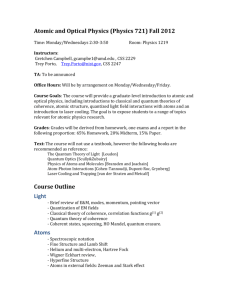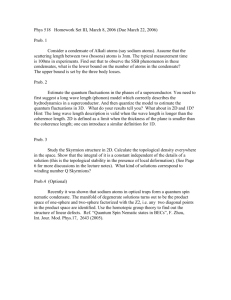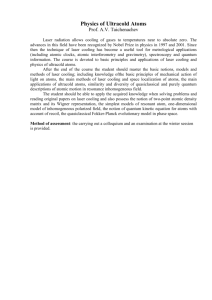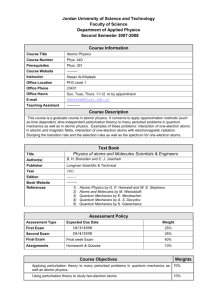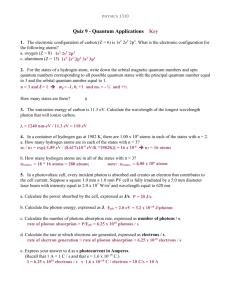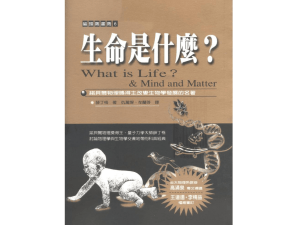Physics 7550 Atomic and Molecular Spectra
advertisement
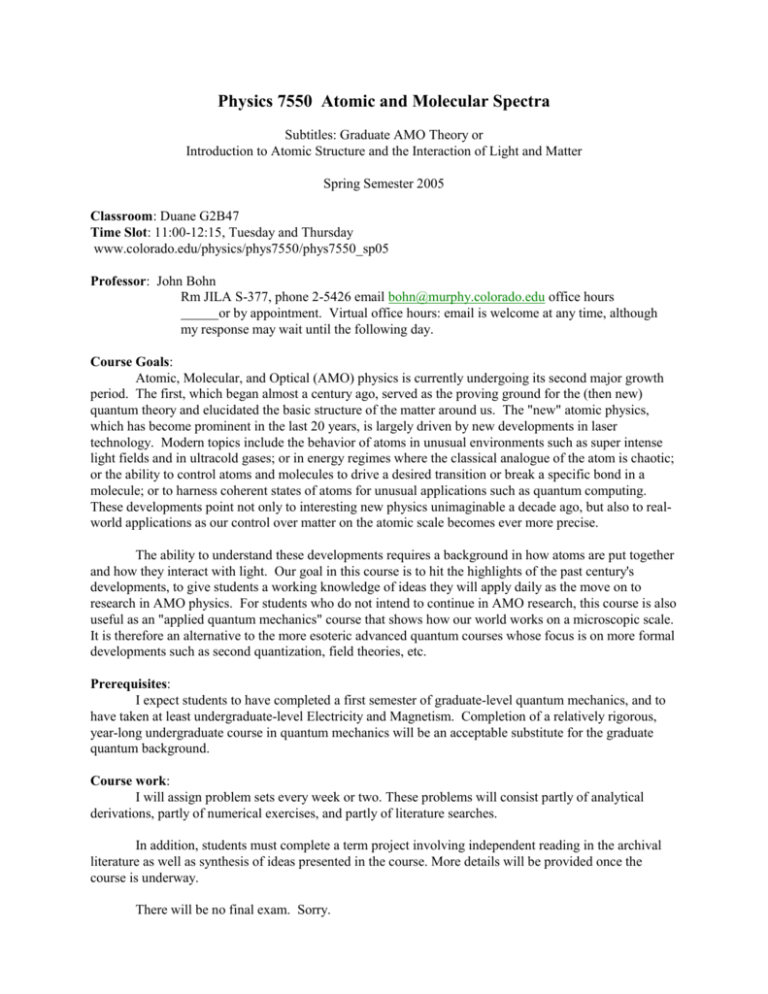
Physics 7550 Atomic and Molecular Spectra Subtitles: Graduate AMO Theory or Introduction to Atomic Structure and the Interaction of Light and Matter Spring Semester 2005 Classroom: Duane G2B47 Time Slot: 11:00-12:15, Tuesday and Thursday www.colorado.edu/physics/phys7550/phys7550_sp05 Professor: John Bohn Rm JILA S-377, phone 2-5426 email bohn@murphy.colorado.edu office hours or by appointment. Virtual office hours: email is welcome at any time, although my response may wait until the following day. Course Goals: Atomic, Molecular, and Optical (AMO) physics is currently undergoing its second major growth period. The first, which began almost a century ago, served as the proving ground for the (then new) quantum theory and elucidated the basic structure of the matter around us. The "new" atomic physics, which has become prominent in the last 20 years, is largely driven by new developments in laser technology. Modern topics include the behavior of atoms in unusual environments such as super intense light fields and in ultracold gases; or in energy regimes where the classical analogue of the atom is chaotic; or the ability to control atoms and molecules to drive a desired transition or break a specific bond in a molecule; or to harness coherent states of atoms for unusual applications such as quantum computing. These developments point not only to interesting new physics unimaginable a decade ago, but also to realworld applications as our control over matter on the atomic scale becomes ever more precise. The ability to understand these developments requires a background in how atoms are put together and how they interact with light. Our goal in this course is to hit the highlights of the past century's developments, to give students a working knowledge of ideas they will apply daily as the move on to research in AMO physics. For students who do not intend to continue in AMO research, this course is also useful as an "applied quantum mechanics" course that shows how our world works on a microscopic scale. It is therefore an alternative to the more esoteric advanced quantum courses whose focus is on more formal developments such as second quantization, field theories, etc. Prerequisites: I expect students to have completed a first semester of graduate-level quantum mechanics, and to have taken at least undergraduate-level Electricity and Magnetism. Completion of a relatively rigorous, year-long undergraduate course in quantum mechanics will be an acceptable substitute for the graduate quantum background. Course work: I will assign problem sets every week or two. These problems will consist partly of analytical derivations, partly of numerical exercises, and partly of literature searches. In addition, students must complete a term project involving independent reading in the archival literature as well as synthesis of ideas presented in the course. More details will be provided once the course is underway. There will be no final exam. Sorry. Textbook: This course has no formal textbook, since I do not know of one that covers the areas covered in this course. I will, however, place on reserve in the Physics Library a set of quite good books, from which I have learned a lot. I encourage you to look these books over and to find the ones that appeal to you. In advance of each lecture, I plan to post suggested reading assignments on the course website, www.colorado.edu/physics/phys7550/phys7550_sp05. These are not mandatory, but of course if you’re already thinking about the subject, the lectures will make more sense. The lecture notes will also be made available on the web, as well as additional interesting material. Course Schedule: The topics and their approximate duration will be as follows. Actual mileage may vary, depending on the interests of the students. I am indebted to Eric Cornell for the organization and presentation of much of this material. Structure of “one electron” atoms and effect of dc fields (2 weeks) Quantization of the electromagnetic field and photon-induced processes (2 weeks) Spectroscopy in the time domain: Bloch sphere dynamics (2 weeks) Incoherent remarks on coherence (2 weeks) Multi-electron atoms (1.5 weeks) Molecular structure (1.5 weeks) A smattering of scattering theory (2 weeks) Special topics (time remaining) The last few lectures of the semester will be on topics in modern AMO to be determined by popular request. (If I lack the necessary expertise to provide the requested lectures, I will bring in a hired gun. There are lots of experts in JILA.) Possible Advanced Topics (roughly three or four of the topics listed below will be covered) 1) Mechanical effects of light. 2) Optical cooling and trapping. 3) Rydberg atoms. 4) Quantum Chaos. 5) Above-threshold photo-ionization. 6) Optical coherence effects in semiconductors 7) Ultracold atomic collisions. 8) Quantum information processing 9) Dirac equation 10) Gross-Pitaevskii equation/BEC dynamics 11) Multiply-excited states of atoms 12) Cavity QED 13) Desperate Housewives

